Best Pea Protein Powder
If you need a dairy-free way to supplement your daily protein intake, we’ve got you covered with the top 6 picks for pea protein powders.
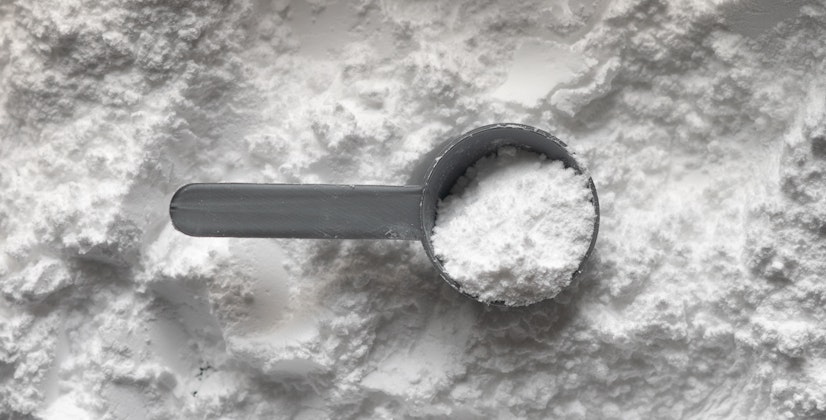
Protein is one of the most important building blocks in our bodies, but not everyone gets the right amount.1 Vegans and vegetarians often eat less protein than their omnivorous counterparts since meat is one of the best sources of protein. Building muscle also requires extra protein intake, so athletes and those trying to get in shape often need more in their diet as well.2
Pea-based protein powders are one of the best ways to get healthy plant-based proteins into your diet without relying on whey (a milk product) or soy. But the market for pea protein powders is vast, and it isn’t often clear what differentiates each product. We’ve narrowed the field down to the six best pea protein powders and tested them for this guide, analyzing their protein content, taste, mixability, cost, and other essential details.
If you don’t have time to dive in right now, check out our top picks below.
Summary of recommendations
- Best overall: Naked Nutrition
- Best tasting (flavored): Nutrasumma Fermented Chocolate
- Best tasting (unflavored): Naked Nutrition
- Best budget pick: Naked Nutrition
- Best protein concentration (unflavored): Naked Nutrition
- Best protein concentration (flavored): Nuzest
- Best organic option: NorCal Organic
- Best workout support: Garden of Life Sport
A simple ingredient profile, high protein concentration, and low cost per serving make Naked Nutrition the best choice for most people.
Naked’s unflavored pea protein contains only pea protein isolate. Compared to other products that boast the same simplicity, this plain pea protein has the lightest flavor, allowing you to enjoy it on its own or mix it into a beverage of your choice. And if you prefer a flavored product, it’s available in chocolate or vanilla, as well. Subscribe to save 20% on your first order.
In this Review
Why you should trust us
At Innerbody Research, we extensively test each health service or product we review, including pea protein powders. We got our hands on the powders we identified as the best options for various user needs and tested them for taste, mixability, and other factors. That level of in-depth analysis and personal experience allows us to relay information to you that you could only get by trying all these different powders yourself.
In addition to our hands-on testing, we scoured the scientific literature and came away with several dozen pertinent articles related to protein supplementation and physical fitness, many of which looked at pea protein specifically. All told, we spent more than 300 hours performing various tests and researching for this guide. Additionally, like all health-related content on this website, this guide was thoroughly vetted by one or more members of our Medical Review Board for accuracy.
Over the past two decades, Innerbody Research has helped tens of millions of readers make more informed decisions about staying healthy and living healthier lifestyles.
How we evaluated pea protein powders
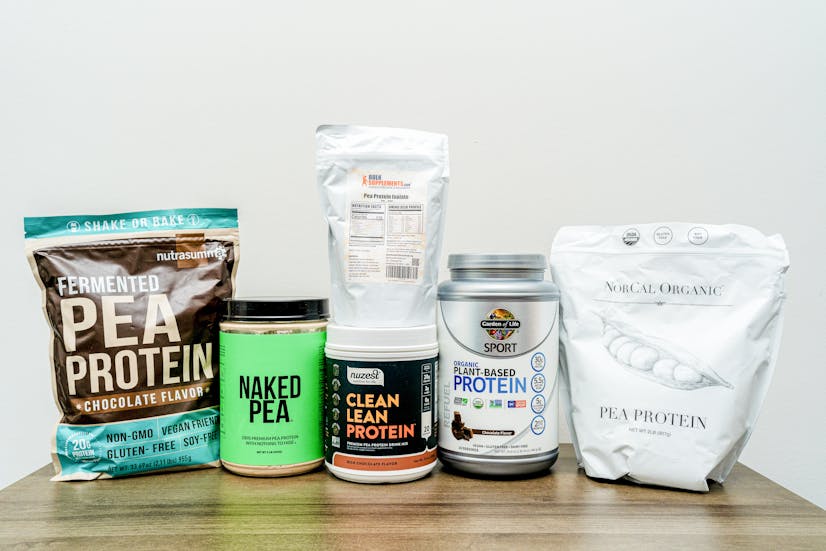
Photo by Innerbody Research
To evaluate pea protein powders, we concentrated on a handful of criteria we could apply across all the brands we scrutinized. Except for taste and mixability, we applied these criteria in the research phase, comparing costs, ingredients, and the customer experience. Once we got hands-on with the products, our evaluation of flavors and performance added critical context to what we’d learned thus far.
We gave the most weight to effectiveness in our rankings, which mostly came down to the protein concentration of a given product, as well as the distribution of its amino acids when that information was available. Taste and mixability were a close second in our consideration, followed by cost and customer support.
In many cases, there’s a best option among flavored protein powders and a different best option among unflavored pea proteins. We’ll discuss those differences below, but winners for each category take both flavored and unflavored options into account.
Let’s take a closer look at each criterion to see how we arrived at our conclusions.
Effectiveness
Winner: Naked Nutrition
There’s no point in adding protein powder to your day if it’s not going to help you reach your health goals. That means it needs to give you a serious protein boost in a reasonable serving size. If a protein powder says it can give you 30g of protein, but it can only do that if you take multiple scoops of powder, the impracticality detracts from the powder’s efficacy. This feature, which we call protein concentration, has an enormous impact on a powder’s efficacy.
Here’s how the protein concentration as a percentage of a single serving breaks down among our top picks:
| Serving size in grams | Grams of protein per serving | Protein to serving weight percentage | |
|---|---|---|---|
| Naked | 30g | 27g | 90% |
| Nutrasumma | 34.1g | 20g | 59% |
| Garden of Life Sport | 44g | 30g | 68% |
| NorCal | 26g | 22g | 85% |
| Nuzest | 25g | 20g | 80% |
As you can see, Naked’s 90% protein concentration is the highest of the bunch. It’s worth noting that this percentage drops if you opt for either the chocolate or vanilla flavors; it’s only 90% for the unflavored pea protein. That’s because flavored powders often contain additional ingredients like sweeteners. Nuzest has the highest protein concentration among flavored options that we’ve reviewed (though we found some of Nuzest’s flavoring to be unpleasant).
Beyond just protein concentration, we also evaluated amino acid profiles (if and when companies made them available) to help us determine the potential efficacy of a given protein powder. The most important amino acids in any breakdown are leucine, isoleucine, and valine, which are known as the branched-chain amino acids (BCAAs). These are associated with significant improvements in athletic performance on their own, but are even more effective in the presence of other amino acids.3 Factors from the specific kind of peas employed to the nuances of a given company’s manufacturing processes will influence the balance of amino acids in a given powder.
Naked’s plain pea protein contains nearly 5.5g of BCAAs. That’s the second-highest BCAA count in any of the products in this guide, falling just 42mg behind Garden of Life’s total.

Photo by Innerbody Research
Taste and mixability
Winner: Naked Nutrition
Not all protein powders are created equally when it comes to taste. Considering you can’t put it in a capsule and avoid the flavor altogether, it’s important to find something that won’t upset your stomach and won’t taste like you’re eating chalk or sawdust, especially for daily consumption. Our team spent more time debating the finer points of taste among protein powders than anything else, which makes sense for a factor that’s ultimately subjective. But the final consensus among our team was that two products stood out for taste and mixability.
Note: We largely focus on chocolate flavors for our comparisons, as it’s a highly popular and widely available option among brands, and it gave us the most direct way to compare one to another. You may have a different preference that could lead you to another of our top picks as you try your options.

Photo by Innerbody Research
Naked’s pea protein stood out for how little of a taste it imparted to plain water. It was, by far, the least impactful of the unflavored pea proteins we tried, the most impactful of which (Bulk Supplements) was noticeably unpleasant. Nutrasumma’s Fermented Pea Protein offered the best experience among flavored options, with a nice balance of chocolate flavor and subtle sweetness. The taste we came to associate with plain pea protein — which many customers will want to avoid — was wholly absent from this product.
Cost
Winner: Naked Nutrition
The cost of a product involves a lot more than just the number on its price tag. We also consider how much it costs you per serving, the available protein per serving, and any subscription options that could save you money or other saving deals.
Here’s a look at how our top picks’ pricing compares.
Special Offer from Naked Nutrition: SAVE 20% When You Subscribe
| Standard cost | Cost per serving | Subscribe & Save cost | Cost per serving with subscription savings | |
|---|---|---|---|---|
| Naked Nutrition | $57.99 | $0.76 | $46.39 first shipment, then $52.19 after | $0.61-$0.69 |
| Nutrasumma Fermented | $40.99 | $1.46 | $36.89 | $1.32 |
| Bulk Supplements | $25.96 | $0.79 | $24.66 | $0.75 |
| NorCal Organic | $39.99 | $1.14 | $33.99 | $0.97 |
| Nuzest | $44.95 | $2.25 | $35.96 | $1.80 |
| Garden of Life Sport | $47.99 | $2.53 | N/A | N/A |
Note: Bulk Supplements offers additional savings when you buy in larger quantities, but their 2.2lb bag is the closest to typical sizes from competitors, providing the most direct comparison on price.
Naked Nutrition is the clear winner for cost, with only Bulk Supplements coming close in price. And considering the fact that Bulk Supplements was our testers’ least favorite taste among all protein powders tested, it makes much more sense to stick with Naked.
Customer support
Winner: Garden of Life
One of the great things about hands-on experience with products like these is that, in acquiring them, we experience everything any other customer would experience. We have to navigate these websites and complete the ordering process, wait for our shipments to arrive, and address questions or concerns to customer service.
After experiencing the customer support infrastructure each brand in this guide provides, Garden of Life emerges as the clear winner. The biggest knock against the company is that they’re the only ones not to offer a subscription savings plan, so you have to manually reorder the product whenever you’re close to running out. That can be a pain, but Garden of Life has readily available phone operators capable of addressing most product and service questions. Some other companies don’t offer phone support at all, and in one case (Nutrasumma), the phone rep just told us to send them an email.
Garden of Life also has the best money-back guarantee of the group. You can try their products for up to 60 days and still get a refund if you’re unsatisfied. Most other companies offer 30 days, and Naked Nutrition only offers 14 days.
Having said all of this, unless you object to buying on Amazon, you’ll find a better price at the Garden of Life store on Amazon. It may seem strange, but since there’s no subscription savings option from their direct website, saving $7 per order on Amazon (or even a bit more, if you subscribe there) is what we’d suggest you do.
How our top recommendations compare
It can be difficult to tease out the little nuances between different kinds of protein powder. To help you out, we’ve put together a chart so you can easily reference the distinctions, overlaps, and best features of our top picks.
Naked also offers their pea protein in a chocolate or vanilla flavor, but the protein concentration plummets when you go the flavored route. And given the plain variety’s light flavor, we recommend it over a flavored alternative.
What is pea protein powder?
Pea protein powder is exactly what it sounds like: protein powder that’s primarily made from peas. Most varieties of peas are exceptionally high in protein, providing a sustainable and vegan alternative to other kinds of protein powder with animal-derived ingredients. Pea protein powder is almost always made from yellow or split peas.
Peas are one of the best non-meat protein sources since one cup of peas has 8g of protein (2g more than one boiled egg, or roughly equal to two-thirds cup of cooked pinto beans).26
There are three main kinds of pea protein.
If you’re looking to use protein powder to help slow down your hunger, pea protein concentrate is your best bet. It’s less processed than isolate, providing less dense protein but maintaining other healthy nutrients, including more fat, carbohydrates, and vitamins like B1, B5, K, and folate.
Pea protein hydrolysate, also known as hydrolyzed pea protein, is less common than isolate or concentrate. It is technically a pea protein isolate, but it has an extra round of processing that alters its chemical composition. After it’s been made, pea protein hydrolysate is cooked in diluted hydrochloric acid and then is pH-neutralized. This partial breakdown of proteins makes it easier to emulsify and neutralizes any bitter or earthy flavors.6
All of the pea proteins we recommend in this guide are pea protein isolates.
What are the benefits of protein?
Protein is one of the most important macronutrients our bodies need for daily functioning.7 Protein helps us build muscle mass, keep metabolism running, and grow hair and nails. Every cell in our bodies contains protein. When we eat protein, our bodies break it down into amino acids, which then repair cells and make new ones.
We need a substantial amount of amino acids to keep these bodily processes running smoothly. Some of these can be made in the body; others need to be consumed through food. These are called essential, nonessential, and conditional amino acids.
There are nine essential amino acids that the human body can’t make:8
Nonessential amino acids can be made by the body, but we can still benefit from getting through our diets.9 These include:
Conditional amino acids are a specific subtype of amino acid.10 They are nonessential amino acids that your body may struggle to produce in sufficient numbers when you’re sick or under stress, so it’s particularly beneficial to add them when your body is under pressure. Conditional amino acids include:
- Arginine
- Cysteine
- Glutamine
- Glycine
- Proline
- Serine
- Tyrosine
Not all protein sources provide you with all 20 amino acids. And some can provide you with all 20, but they fall short in quantity for one or two. If you’re interested in learning more about amino acids, including branch-chain amino acids (BCAAs), we have a guide that can help.
Benefits of protein powder
Protein powder can supplement these essential and nonessential amino acids that may be missing from your diet or need to be bolstered if you’ve recently been stressed. Muscle damage — which happens when you work out — is the first step in the process that creates new muscles, and muscles are made of and repaired with these proteins. Ensuring that you eat enough protein means your body can fix sore muscles and build new ones.2 And if you can’t eat the recommended daily amount of protein, a protein powder will help you make up the difference.
Pea protein powder versus other protein powders
Pea protein powder has some obvious advantages over other kinds of protein powder. Pea protein is one of the most complete forms of protein that is vegan-friendly, allowing those who can’t or don’t eat meat, dairy, or other animal products to meet their daily protein requirements. Peas are also relatively allergy-friendly, and most pea protein powders are free of the top eight allergens (milk, eggs, fish, shellfish, tree nuts, peanuts, wheat, and soy). Plus, pea protein powder is one of the most sustainable options — making pea protein emits between four and seven times fewer greenhouse gasses than making whey protein from milk.11
On a nutritional front, peas have a considerable amount of fiber, which can help you feel more satisfied for longer. Processing pea protein isolate strips a lot of this fiber from protein powder, however, which reduces some of its benefits but minimizes the risk of bloating and GI problems from taking too much.
While whey protein is a good source of calcium and potassium, pea protein is a good source of iron — another big benefit for vegans.12 It has a more comprehensive amino acid profile than other vegan protein sources like rice and quinoa, meaning there are fewer gaps that your body can’t fill.
There’s a popular misconception that pea protein is an incomplete source because it doesn’t have an especially high quantity of the essential amino acid methionine. Some protein manufacturers have contributed to this misconception by advertising their mixes-source protein powders as superior.
In Naked’s Pea Protein, you’ll find 294mg of methionine per serving. In the same company’s whey protein, you’ll find 480mg. That’s not an especially meaningful difference. And WHO recommendations for daily methionine consumption at the “upper range of individual requirements” are only 13mg/kg of body weight.13 In the U.S., the average male weighs about 200lbs.26 That equates to a daily methionine requirement of a little under 1,200mg. That number is closer to 1,000mg for the average American woman.
And most adults get plenty of methionine from their diets, with abundant amounts in meat, fish, and eggs. Great vegan sources of methionine include tofu and other soy products, sunflower seeds, and Brazil nuts.13
How much protein do you need per day?
Several different factors determine how much protein you should consume daily. Your age, sex, activity level, and whether you’re pregnant affect your daily protein needs; men, active people, teenagers and older adults, and pregnant people all need more protein.
So, what do the professionals say? Well, you’ll get a different answer depending on whom you ask and when you ask them. Some standards are based on reports that are nearly 20 years old, while other more recent guidelines have so many caveats that they can be impossible to calculate for yourself. The American College of Sports Medicine recommends 0.35g per pound of body weight but doesn’t offer guidance for different sexes, body masses, or fitness goals.14 There are also several protein calculators online to help you determine the right amount of protein for your daily diet and decide if starting to take a protein powder is right for you.
Who is pea protein powder best for?
Pea protein powder is an excellent vegan alternative to standard protein powders, which are often made with whey or soy. It provides healthy, sustainable protein to those who can’t have dairy but want to supplement their diet. Since vegans don’t have access to most sources of complete protein, protein powders can supplement missing amino acids from dietary restrictions.
But you don’t have to be vegan to enjoy pea protein powders. Anyone who wants to bring more protein into their diet — whether for building muscle, keeping your body moving through strenuous workouts, or feeling satiated for longer periods — can benefit from this supplemental source.
Is pea protein powder safe?
For most people, yes. Pea protein powder offers virtually identical benefits to eating several servings of split peas. That’s one of the biggest benefits of pea protein powder — it’s a very safe way of bulking up your daily diet. However, since it isn’t technically a food or medication, it isn’t regulated in the same way by the FDA.
Eating a large quantity of peas can also mean eating a lot of fiber, which can cause stomach upset in some people. While most of the protein powders on our list strip a significant portion of fiber out of their formulas to avoid this, you may still experience some gas and bloating. This is also true for those with FODMAP sensitivities, as pea proteins can have varying levels of FODMAPs depending on their processing.15 Of course, if you’re allergic to peas, steer clear.
Pea protein powder isn't a great option if you have gout or a history of kidney problems.16 It contains purines, which break down into uric acid. Uric acid crystallizes in joints when you have gout, so it can make your symptoms worse. Talk to your doctor before starting a pea-based protein powder.
Most pea protein powders are safe for those who are pregnant or lactating. Still, reach out to your doctor first to confirm that there aren’t any potential risks you may not realize. Also, it’s unlikely that a child would need the extra protein intake that pea protein powder provides, but supplementation, in most cases, wouldn’t be harmful. Consult with your pediatrician if you’re considering adding pea protein powder to their diet.
Naked Nutrition Pea Protein Powder
Best overall, best tasting (unflavored), best budget pick, and best protein concentration (unflavored)

Photo by Innerbody Research
Pros
- Very high protein concentration
- Processed without chemicals or artificial sweeteners
- Independently tested for heavy metals and allergens
- Informed Choice Trusted by Sport certification
- Available in three flavors
- 5lb containers give you more than two and a half months of servings
- Get 15% off your first order when you sign up for their newsletter
- Free shipping over $99
- Subscribe & Save 20% on your first order
Cons
- Flavored protein powders have slightly lower protein per serving
- Subscribe & Save discount drops to 10% after your first order
- Flavors unavailable in a 1lb size
If you’re looking for a healthy dose of protein from only one ingredient — split peas grown on North American farms — Naked Nutrition’s Pea Protein Powder is likely your best bet. This pea protein powder offers 27g of protein per 30g serving and 16% of your daily iron requirements at 120 calories. It’s available in 5lb containers, guaranteeing that most people will have protein for more than two and a half months without having to order a refill. Each batch of Pea Protein Powder is independently tested for heavy metals and common allergens, such as gluten.

Photo by Innerbody Research
This pea protein powder comes in three flavors: unflavored, chocolate, and vanilla. Both chocolate and vanilla flavors include two more ingredients than the unflavored version — coconut sugar and either cocoa powder or vanilla flavoring. They have slightly less protein, too, at 25g per serving. The flavored versions are also only available in 5lb containers, whereas the unflavored variety is available at 1lb or 5lb.
Our results from testing Naked Nutrition Pea Protein
Of the three top contenders among unflavored pea proteins that our testing team evaluated — Naked Nutrition, Bulk Supplements, and NorCal Organic — Naked’s emerged as a clear winner for taste. Unflavored pea proteins typically don’t taste good. Other unflavored contenders on this list had noticeably earthy tastes and slightly bitter aftertastes. But Naked Nutrition’s was the lightest of the bunch, imparting only a light earthiness to plain water and leaving no aftertaste.

Photo by Innerbody Research
Testing unflavored pea protein in plain water might only be somewhat fair to these brands, but we applied the same standards to all of them. That said, the lightness of Naked’s product allowed it to blend in more comprehensively with smoothies and plain, unsweetened almond milk in further testing.
NorCal Organic’s pea protein blended a bit better, resulting in a smoother product with a less chalky mouthfeel, but its slightly bitter aftertaste had our testers preferring Naked in almost every instance.
Naked Nutrition pricing
Currently, Naked Nutrition offers one size container for all three of their flavors (unflavored, chocolate, and vanilla): 5lb. You can also get the plain variety in a 1lb container. Subscription savings are 20% for your first month and 10% for subsequent months. Here’s how it works out:
| 1lb container | 5lb container | |
|---|---|---|
| One-time purchase | $16.49 | $57.99 |
| Subscription (first month) | $13.19 | $46.39 |
| Subscription (subsequent months) | $14.84 | $52.19 |
| Available flavors | Plain | Plain, Chocolate, Vanilla |
At these prices, your cost per serving and cost per gram of protein are lower than with any other company on our list. Bulk Supplements can theoretically beat these prices, but you’d have to buy 11lb of product at once to reach those prices, and the startup cost for such a purchase is well over $100.
You can have these delivered every one, two, or three months, and you can skip or cancel your subscription anytime. You’ll need to spend at least $99 to get free shipping from Naked Nutrition, so just ordering one container of Pea Protein Powder will cost $7.00 for standard shipping (5-7 business days) and $13.99 for expedited shipping (2-3 business days).
If you decide that their pea protein powder isn’t right for you, you can return an unopened and unused container within 14 days of ordering it for a full refund, minus the shipping cost. This is the shortest guarantee of the companies on our list, most of which offer 30 days. Garden of Life offers 60 days.
NorCal Organic
Best organic option
Pros
- Good protein concentration
- Low cost per gram of protein
- Third-party tested for safety and nutritional accuracy
- Test results available on the company website
- One serving provides 30% of your daily iron intake
- Flavor is light and easy to mask in a smoothie
- Subscribing can save you 15%
Cons
- Bitter aftertaste when mixed in plain water
- Test results are not batch-specific
- No mixing instructions for how much liquid to use per serving
- Free shipping only applies to subscription orders
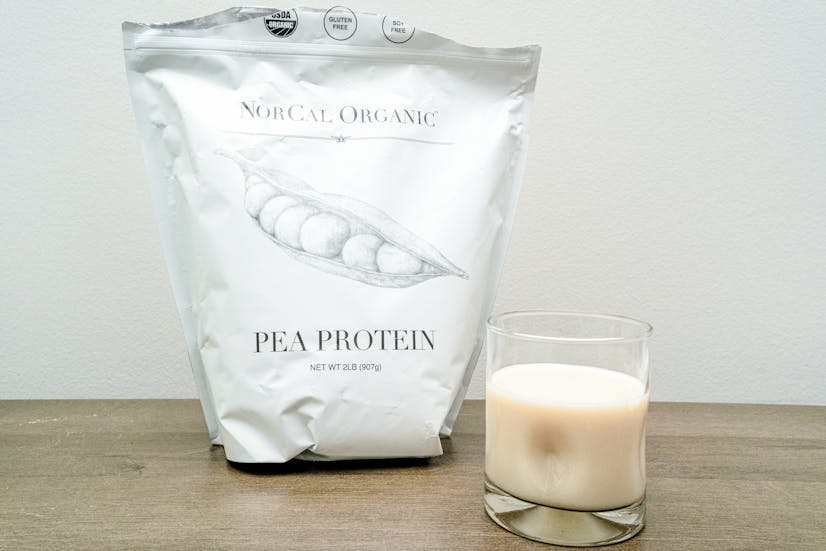
Photo by Innerbody Research
The first thing we noticed about NorCal Organic was the simplicity of the packaging. A black and white hand-drawn image of a pea pod floating in a white void. When we see packaging like this, we expect the product to be expensive. But at $40 for a 2lb bag, NorCal’s Pea Protein has a relatively low cost per serving among pea proteins on our list. However, upon closer inspection, we find that it’s the most expensive of the plain, unflavored pea proteins.
What you get for that price is a pea protein that can’t compete with Naked in terms of taste, but that can claim organic status, which Naked cannot. You could reach for Bulk Supplements’ Organic Pea Protein to get an organic product at a better price, but NorCal tastes much better. And with subscription savings bringing the cost down to $34/bag and unlocking free shipping, the overall cost becomes more bearable.
NorCal’s Pea Protein contains 22g of protein at just 100 calories per serving. That’s one of the lowest calorie counts of any protein powder in our guide, making this a good choice for those using supplemental protein for weight loss, especially if they’re counting calories.
Here is the breakdown of amino acids in a serving of NorCal’s pea protein:
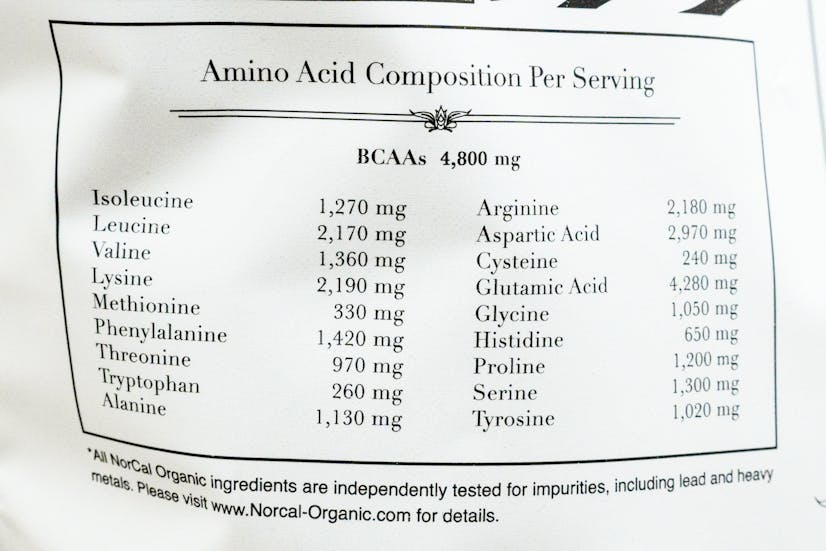
Photo by Innerbody Research
NorCal also sells a handful of other protein powders and powdered beverages like oat milk. The company subjects their products to third-party testing at two stages in the process. The peas are tested before the protein isolation process and again after the powder is complete. The other companies that have third-party testing in this guide typically only test after the product is complete. And NorCal provides testing reports to the public, but these are not batch-specific. That means you can’t trace a specific bag of their protein powder to a recently performed test to find out exactly how your powder performed.
Our results from testing NorCal Organic Pea Protein
NorCal’s pea protein was well-liked among our testers. It had one of the nicest mouthfeels of the unflavored brands we tried, and its initial taste was light and pleasant. A few moments after swallowing, a slight bitterness cropped up, which we didn’t experience with Naked’s unflavored protein.
One of the more frustrating things about NorCal’s protein is its lack of instructions. Most other protein powders say something like, “Mix one scoop in 8-10oz of your preferred liquid.” But NorCal does not provide such a liquid range, and we prefer to use those ranges in testing to give each company a fair trial at the ratios they believe best fit their products.

Photo by Innerbody Research
Given the similarities in the products, we used the same liquid-to-powder ratio recommended by Naked for their protein powder.
NorCal Organic pricing
As we mentioned above, NorCal’s Pea Protein is less expensive per serving than many other flavored options, but it’s the most expensive of the unflavored proteins we saw fit to include in this guide. The 15% subscription discount is a nice option, and you can space out deliveries every one, two, or three months.
Here’s how NorCal’s pricing works out:
| One-time purchase | Subscription | |
|---|---|---|
| Price | $39.99 | $33.99 |
| Shipping | $8 | Free |
| Cost per serving (shipping included) | $1.37 | $0.97 |
NorCal offers a 30-day money-back guarantee that will refund your purchase price minus shipping costs if you’re unsatisfied. Given the high $8 shipping charge for one-time purchases and the fact that canceling a subscription is penalty-free, we recommend starting with the subscription to get the lowest price and save yourself potential costs if you decide to return it later.
Bulk Supplements Organic Pea Protein Isolate
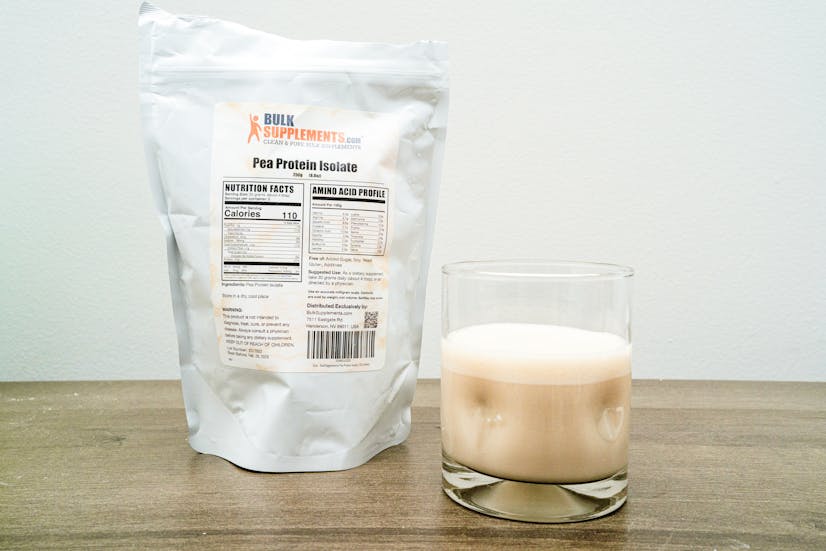
Photo by Innerbody Research
Pros
- Wide range of container sizes
- Good prices for an organic option
- Third-party testing on all supplements
- Save 5% using discount code INNERBODY5, and save 10% by signing up for their app
- Free shipping on orders over $59 to the contiguous United States
Cons
- Low Subscribe & Save discount
- Largest size frequently out of stock
- Testing results are not provided
- Partial refunds equivalent to smallest unit price
- You pay shipping charges on returns
Bulk Supplements offers a huge range of supplements at discount prices, from green tea powder and beets to vitamin A and zinc. They also subject their product to third-party testing, though the results of that testing are not provided.
This pea protein powder is another example that exclusively uses pea protein isolate. There are no other ingredients, so it’s an unflavored powder without any flavored options. Though it’s unflavored, it has a slightly sweet tinge, making it excellent to add to sweet-leaning foods like shakes and smoothies. It tends to be a little thicker than other pea isolate powders but isn’t gritty. Every serving has 21g of protein and 110 calories.

Photo by Innerbody Research
Our results from testing Bulk Supplements Organic Pea Protein
So, Bulk Supplements offers a well-priced pea protein that’s organic, third-party-tested, and available in bulk quantities. That sounds like a good deal until you taste it. Our testers unanimously found this the most bitter of the unflavored pea proteins we sampled. It mixed exceptionally well, but it left a thick layer of foam at the top of the beverage, thick enough that you have to drink your way through it to get to the liquid beneath.
It’s possible that, in the right beverage, you could disguise the flavor, but we can only recommend this product to those who are determined to consume an organic pea protein but don’t want to pay the prices NorCal is asking for theirs.
Bulk Supplements pricing
You can order anywhere from a 3.5oz bag to a 44lb bag of pea protein powder, giving you the flexibility to sample it or get bulk discounts so that you never run out. (Their 44lb bag is frequently out of stock, so we won’t be discussing it in more detail below.)
We’ve put together a chart to compare the costs of these different sizes with both a one-time purchase and a Subscribe & Save discount. Because the Subscribe & Save program only offers 5% savings, the overall value per serving doesn’t change.
| Standard price | Subscribe & Save price | |
|---|---|---|
| 3.5oz | $11.96 | $11.36 |
| 8.8oz | $16.96 | $16.11 |
| 1.1lb | $19.96 | $18.96 |
| 2.2lb | $25.96 | $24.66 |
| 11lb | $118.96 | $113.01 |
The price per gram of protein here can only compete with Naked’s if you buy at least 11 pounds at a time. And considering Naked’s superior flavor profile, it’s hard to argue in favor of Bulk Supplements here.
Bulk Supplements offers free shipping to the contiguous United States on orders over $59. That means you have to buy at least three 2.2lb bags or one 11lb bag to qualify for free shipping. If you don’t meet that threshold, shipping costs a flat fee of $9.95, the most expensive of the companies in our guide. And unlike NorCal, which offers free shipping for subscribers regardless of the amount spent, subscriptions through Bulk Supplements do not unlock free shipping.
If you live in Alaska, Hawaii, Puerto Rico, or in a different country, you’ll pay varying amounts depending on your exact location, how fast you want your package, and how much it weighs.
Bulk Supplements will let you return a product for up to 30 days, but you’ll only receive compensation for the lowest available amount sold of that product. So, if you buy 11 pounds of pea protein powder and want to return it, you’ll only be eligible to receive a return of about $12.
Nutrasumma Fermented Pea Protein
Best tasting (flavored)
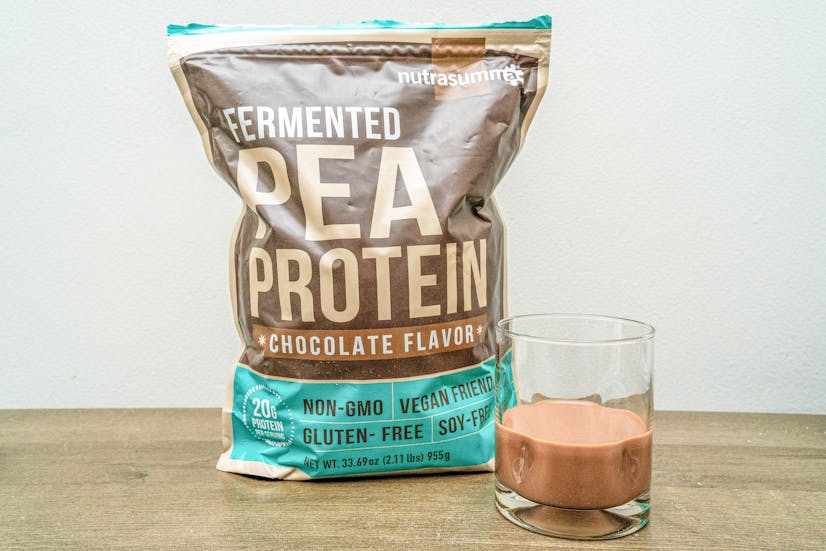
Photo by Innerbody Research
Pros
- Best tasting flavored option as determined by our testing team
- Fermentation may enhance bioavailability
- Lowest cost per serving among flavored options
- Highest iron content of the products in our guide
- Mixes very smoothly into beverages and yogurt
Cons
- Poor customer service
- Contains stevia and cocoa processed with alkali
- Protein concentration is lower than most
- No evidence of third-party testing
Nutrasumma’s Fermented Pea Protein Powder was somewhat divisive within our testing team. On the one hand, its flavor and texture were highly rated, its fermentation process may offer increased bioavailability, and its price is reasonable.25 On the other hand, its ingredient profile wasn’t as clean as competitors, details of its fermentation process were scarce, and its protein concentration could have been higher.
This product provides 20g of protein and an impressive 7mg of iron at 120 calories per serving. It contains 3g of added sugars (cane sugar, to be exact), which might turn off those with blood sugar issues or on ketogenic diets. The cocoa in the chocolate flavor is also processed with alkali, which can cause digestive issues for some.
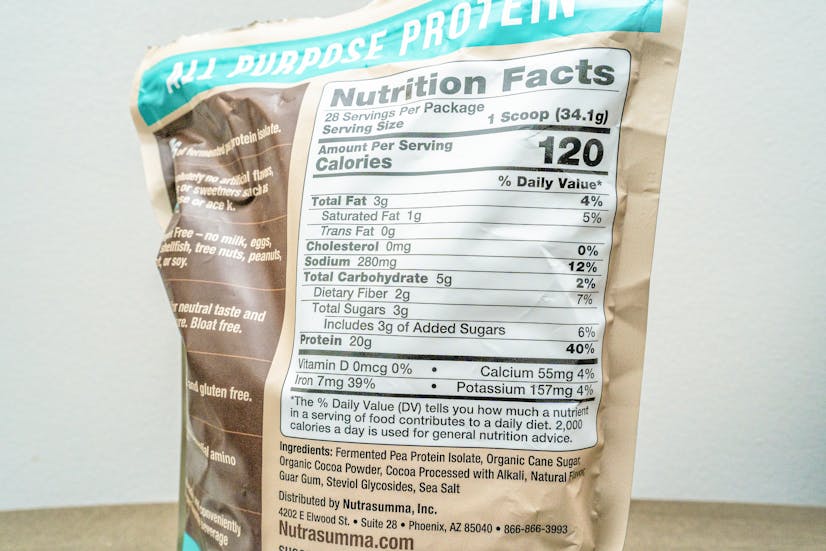
Photo by Innerbody Research
Ultimately, Nutrasumma’s product is ideal if flavor and texture are your main concerns, and you just want a protein powder to help increase your daily intake regardless of other ingredients involved.
Our results from testing Nutrasumma Fermented Pea Protein
This powder offered the best taste and texture of anything our team tried. The chocolate flavor was well-defined and not too sweet, and there was no hint of pea flavor lurking in the background. There was a subtle bitterness, but our testers likened it to the bitterness of a good dark chocolate, and it combined well with the added sea salt to elevate the flavor significantly above competitors.
Garden of Life offered the next best thing in terms of flavor, but we could clearly taste the pea protein in it much more than we could with Nutrasumma.
Nutrasumma pricing
Nutrasumma has the lowest price per serving of our top-rated flavored pea proteins, and the company provides free shipping at a lower point ($50) than most others. A 10% discount is available for subscriptions. But the free shipping won’t apply if you aim to order just one container of the product. Here’s what the pricing looks like:
| One-time purchase | Subscription | |
|---|---|---|
| Price | $40.99 | $36.89 |
| Shipping | $5.95 | $5.95 |
| Cost per serving (shipping included) | $1.68 | $1.53 |
Because of this shipping fee, we recommend you buy from the Nutrasumma store on Amazon instead, unless you know you want to subscribe. There, you get free shipping automatically, saving you over 14% of your cost on a single order.
Like most of the companies in this guide, Nutrasumma offers a 30-day money-back guarantee. However, their closest competitor for taste and performance, Garden of Life, offers 60 days and has a lower free shipping threshold of just $25.
Garden of Life Sport Organic Plant-Based Protein
Best for workout support
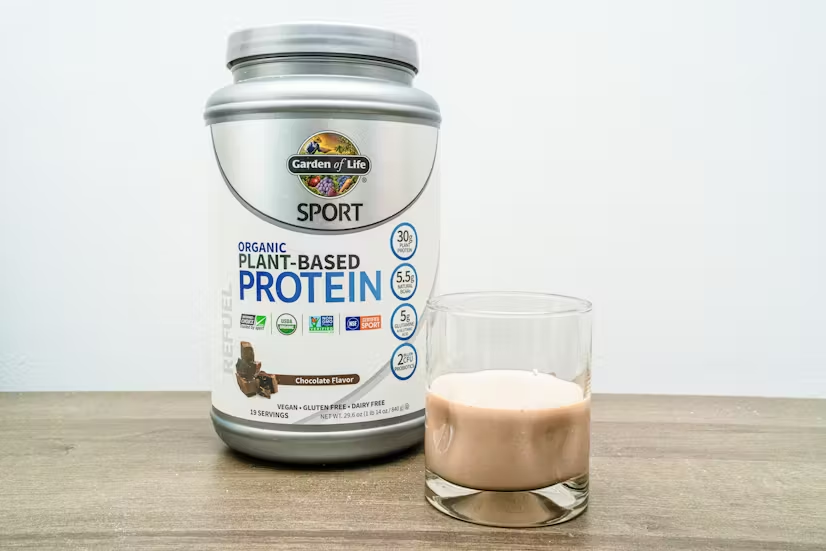
Photo by Innerbody Research
Pros
- Highest BCAA count per serving in our guide
- Light but pleasant chocolate flavor
- Combines five sources for a more complex protein
- Lower free shipping threshold than competitors ($25)
- Includes a recovery blend with turmeric and probiotics
Cons
- Only 19 servings per container
- High cost per serving
- No option to subscribe
Garden of Life products take a more holistic approach to establishing an ingredient profile than most competitors. That means an ingredient list will often include components you don’t typically expect to see in something like a protein powder. In the case of Garden of Life Sport, those extra ingredients include probiotics, botanicals like turmeric and tart cherry, and protein sources from the following:
- Peas
- Sprouted navy beans
- Sprouted lentil beans
- Sprouted garbanzo beans
- Cranberry seeds
The reason Garden of Life Sport gets our pick for best workout support is that it offers the highest quantity of BCAAs among our top picks at 5,502mg. The next closest competitor is Naked’s unflavored pea protein with 5,460mg. It also includes a recovery blend containing turmeric, tart cherry, and other ingredients that may help reduce delayed onset muscle soreness.24

Photo by Innerbody Research
All told, Garden of Life Sport gets you 30g of protein and 3.4mg of iron from one 180-calorie serving. That’s a bit more calorie-dense than the other flavored options in our guide, but those extra calories may come in handy if you’re looking to build muscle.
Our results from testing Garden of Life Sport Organic Pea Protein
For most of our testing team, this was considered a close runner-up in taste and texture to Nutrasumma’s fermented pea protein. It has a lighter chocolate flavor with a whole-grain taste that’s reminiscent of some unsweetened wheat-based cereals. Behind those flavors was a bit of the bitter aftertaste associated with pea proteins, which held the product back from truly competing with Nutrasumma for taste.
An important textural note, though: one serving of Garden of Life Sport is 44g. That’s nearly 10g more material than Nutrasumma. This results in a slightly thicker beverage overall (though still smooth), and it makes it especially difficult to mix into a standard 6oz serving of yogurt.
Garden of Life Sport Pricing
A single 29.6oz container of Garden of Life Sport Organic Plant-Based Protein costs $47.99. That’s nearly as much as the 5lb container from Naked that gives you more than twice as much powder. And Garden of Life does not offer any kind of subscription savings platform, so you’re left paying more and having to remember to reorder when you’re getting low. They’re the only company in our guide not to offer subscriptions for their products.
One thing working in Garden of Life's favor is that they offer free shipping on orders over $25. They’re the only company in our guide with a shipping threshold below the cost of their protein, ensuring that you’ll get free shipping on your order. They also have the longest money-back guarantee of the group, offering 60 days to the 30 days that most others provide.
Still, you’re best bet is to buy it from Amazon and save considerable money.
Nuzest Clean Lean Protein
Best protein concentration (flavored)
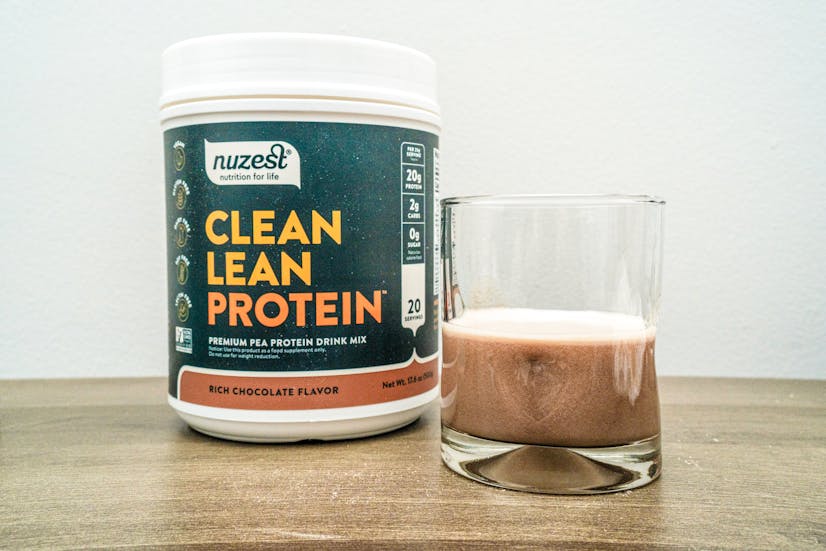
Photo by Innerbody Research
Pros
- High protein concentration for a flavored powder
- Very simple ingredient profile
- Five flavor options (the most in our guide)
- Only 100 calories per serving
- Deep 20% discount for subscribing
Cons
- Least popular taste among our testing team
- Lowest BCAA count in our guide
- Highest cost per gram of protein in our guide
- High threshold for free shipping ($70)
For a flavored pea protein powder, Nuzest’s Clean Lean Protein has a remarkably short ingredient list. The vanilla flavor only contains pea protein, natural flavors, and thaumatin. Other flavors add only one or two more ingredients, such as the beetroot powder to give the strawberry flavor its pink hue or the cocoa powder in the chocolate flavor. All told, Nuzest offers their protein in five flavors:
- Just Natural
- Smooth Vanilla
- Real Coffee
- Rich Chocolate
- Wild Strawberry
One ingredient that might be new to many readers is thaumatin, a sweetener derived from the Thaumatococcus daniellii plant. The sweetener is generally recognized as safe (GRAS) by the FDA, and it appears not to affect blood sugar. Studies looking at obscene amounts of thaumatin consumption in rats and dogs revealed no cause for alarm regarding toxicity, either.17 But what does thaumatin taste like?
Our results from testing Nuzest Clean Lean Protein
Our testers’ first reaction to the chocolate-flavored Nuzest was decidedly negative. It’s hard to say whether the issue with the taste arose from the specific natural flavors or from the thaumatin used to sweeten the beverage. Our suspicions lie with the thaumatin, as the cloying and difficult-to-swallow aspect of the drink was sweetness (though some natural flavors can also impart sweetness). This other flavor outshone the chocolate, which just couldn’t compete. On the bright side, we didn’t encounter the trademark bitterness associated with many pea proteins.
We had to regroup after this first tasting and return to the drink with a different set of expectations. Compared to the chocolate offerings from Garden of Life and Nutrasumma, Nuzest is not very chocolatey. More than anything else, it’s fruity. But its fruitiness does not blend well with whatever chocolate flavor is present, and more careful tasting revealed to us that this clash was the reason we disliked it. The strawberry flavor is most likely to be a hit, as its berry essence will blend much better with the fruitiness we encountered.
Nuzest pricing
While Nuzest isn’t the most expensive option per serving (that accolade goes to Garden of Life), its 20g of protein per serving combines with its price to make it the most expensive option per gram of protein. However, Nuzest offers the steepest subscription discount in our guide at 20%, beating out the 15% offered by Naked and NorCal. Here’s how that affects cost per serving and cost per gram of protein:
| One-time purchase | Subscription | |
|---|---|---|
| Price | $44.95 | $35.96 |
| Cost per serving | $2.25 | $1.80 |
| Cost per gram of protein | $0.12 | $0.09 |
Even with the subscription discount, $0.09/g is more expensive than the other options in our guide. Nuzest offers larger containers of protein that hold 40 or 100 servings, but the up-front costs for these are very high, and they don’t meaningfully impact these deeper costs. Add Nuzest’s $9 shipping charge and $70 free shipping threshold, and the price worsens.
Nuzest is mostly going to be a good choice for people who don’t want a chocolate or vanilla option but still want some built-in flavor. It’s also got the highest protein concentration of any flavored option in our guide, not because it has a high protein count per serving but because its serving size is relatively small. That allows it to mix into beverages and yogurt more easily than most others.
FAQ about pea protein powder
Sources
Innerbody uses only high-quality sources, including peer-reviewed studies, to support the facts within our articles. Read our editorial process to learn more about how we fact-check and keep our content accurate, reliable, and trustworthy.
Pezeshki, A., Zapata, R. C., Singh, A., Yee, N. J., & Chelikani, P. K. (2016). Low protein diets produce divergent effects on energy balance. Scientific Reports, 6.
Carbone, J. W., & Pasiakos, S. M. (2019). Dietary Protein and Muscle Mass: Translating Science to Application and Health Benefit. Nutrients, 11(5).
Jäger, R., Kerksick, C.M., Campbell, B.I., Cribb, P.J., Wells, S.D., Skwiat, T.M., Purpura, M., Ziegenfuss, T.N., Ferrando, A.A., Arent, S.M., Smith-Ryan, A.E., Stout, J.R., Arciero, P.J., Ormsbee, M.J., Taylor, L.W., Wilborn, C.D., Kalman, D.S., Kreider, R.B., Willoughby, D.S., Hoffman, J.R., Krzykowski, J.L., Antonio, J. (2017). International Society of Sports Nutrition Position Stand: Protein and exercise. Journal of the International Society of Sports Nutrition, 14.
Lam, A.C.Y., Can Karaca, A., Tyler, R.T. & Nickerson, M.T. (2018). Pea protein isolates: Structure, extraction, and functionality. Food Reviews International, 34:2, 126-147.
Sandberg, A. (2011). Developing functional ingredients: A case study of pea protein. Functional Foods (Second Edition), 358-382.
Tamm, F., Herbst, S., Brodkorb, A., & Drusch, S. (2016). Functional properties of pea protein hydrolysates in emulsions and spray-dried microcapsules. Food Hydrocolloids, 58, 204-214.
Poos, M.I., Costello, R., Carlson-Newberry, S.J., & the Institute of Medicine. (1999). Committee on Military Nutrition Research: Activity Report: December 1, 1994 through May 31, 1999: The Role of Protein and Amino Acids in Sustaining and Enhancing Performance. National Academies Press.
Church, D. D., Hirsch, K. R., Park, S., Kim, Y., Gwin, J. A., Pasiakos, S. M., Wolfe, R. R., & Ferrando, A. A. (2020). Essential Amino Acids and Protein Synthesis: Insights into Maximizing the Muscle and Whole-Body Response to Feeding. Nutrients, 12(12).
Tipton, K. D., Gurkin, B. E., Matin, S., & Wolfe, R. R. (1999). Nonessential amino acids are not necessary to stimulate net muscle protein synthesis in healthy volunteers. The Journal of Nutritional Biochemistry, 10(2), 89–95.
de Koning T. J. (2013). Amino acid synthesis deficiencies. Handbook of Clinical Neurology, 113, 1775–1783.
Loveday, S. M. (2019). Food Proteins: Technological, Nutritional, and Sustainability Attributes of Traditional and Emerging Proteins. Annual Review of Food Science and Technology.
Patocka, G., & Jelen, P. (1991). Calcium Association With Isolated Whey Proteins. Canadian Institute of Food Science and Technology Journal, 24(5), 218-223.
Nuru, M., Muradashvili, N., Kalani, A., Lominadze, D., & Tyagi, N. (2018). High methionine, low folate and low vitamin B6/B12 (HM-LF-LV) diet causes neurodegeneration and subsequent short-term memory loss. Metabolic Brain Disease, 33(6), 1923.
American College of Sports Medicine. (2015). Protein Intake for Optimal Muscle Maintenance. ASCM.
Nanayakkara, W. S., Skidmore, P. M., Wilkinson, T. J., & Gearry, R. B. (2016). Efficacy of the low FODMAP diet for treating irritable bowel syndrome: The evidence to date. Clinical and Experimental Gastroenterology, 9, 131-142.
Jakše, B., Jakše, B., Pajek, M., & Pajek, J. (2019). Uric Acid and Plant-Based Nutrition. Nutrients, 11(8).
Younes, M., Aquilina, G., Castle, L., Engel, H., Fowler, P., Frutos Fernandez, M. J., Fürst, P., Gürtler, R., Husøy, T., Manco, M., Mennes, W., Passamonti, S., Moldeus, P., Shah, R., Wölfle, D., Wright, M., Batke, M., Boon, P., Bruzell, E., . . . Vianello, G. (2021). Re‐evaluation of thaumatin (E 957) as food additive. EFSA Journal, 19(11).
U.S. Department of Agriculture, & U.S. Department of Health and Human Services. (2020). Dietary Guidelines for Americans, 2020-2025. dietaryguidelines.gov
Ortinau, L. C., Hoertel, H. A., Douglas, S. M., & Leidy, H. J. (2014). Effects of high-protein vs. High- fat snacks on appetite control, satiety, and eating initiation in healthy women. Nutrition Journal, 13.
Adamska-Patruno, E., Ostrowska, L., Goscik, J., Pietraszewska, B., Kretowski, A., & Gorska, M. (2018). The relationship between the leptin/ghrelin ratio and meals with various macronutrient contents in men with different nutritional status: A randomized crossover study. Nutrition Journal, 17.
Gannon, M. C., Nuttall, F. Q., Saeed, A., Jordan, K., & Hoover, H. (2003). An increase in dietary protein improves the blood glucose response in persons with type 2 diabetes. The American Journal of Clinical Nutrition, 78(4), 734–741.
Aragon, A. A., & Schoenfeld, B. J. (2013). Nutrient timing revisited: Is there a post-exercise anabolic window? Journal of the International Society of Sports Nutrition, 10, 5.
Kerksick, C. M., Arent, S., Schoenfeld, B. J., Stout, J. R., Campbell, B., Wilborn, C. D., Taylor, L., Kalman, D., Smith-Ryan, A. E., Kreider, R. B., Willoughby, D., Arciero, P. J., VanDusseldorp, T. A., Ormsbee, M. J., Wildman, R., Greenwood, M., Ziegenfuss, T. N., Aragon, A. A., & Antonio, J. (2017). International society of sports nutrition position stand: Nutrient timing. Journal of the International Society of Sports Nutrition, 14.
Yoon, Y., Lee, K., & Kim, J. (2020). Curcumin supplementation and delayed onset muscle soreness (DOMS): Effects, mechanisms, and practical considerations. Physical Activity and Nutrition, 24(3), 39-43.
Samtiya, M., Aluko, R. E., Puniya, A. K., & Dhewa, T. (2021). Enhancing Micronutrients Bioavailability through Fermentation of Plant-Based Foods: A Concise Review. Fermentation, 7(2), 63.
National Center for Health Statistics. (2021, January). Anthropometric Reference Data for Children and Adults: United States, 2015–2018: Analytical and Epidemiological Studies. U.S. Department of Health and Human Services, Centers for Disease Control and Prevention.






